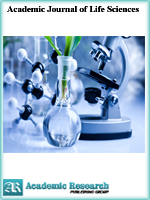Academic Journal of Life Sciences
Online ISSN: 2415-2137
Print ISSN: 2415-5217
Print ISSN: 2415-5217
Quarterly Published (4 Issues Per Year)

Archives
Volume 6 Number 3 March 2020
Capabilities of Algae to Be Utilized As a Renewable Energy Source
Authors: Abdel Moneim Elhadi Sulieman ; Eitimad H. Abdel Rahman ; Waleed Abdelrahman Mustafa
Pages: 18-26
DOI: doi.org/10.32861/ajls.63.18.26
Abstract
Algae are simple plants and most of them are aquatic and can grow in different water assets, for example, fresh water, salty water, and wastewater so they are considered as the more secure, non-focused and more effective plant. They have different pathways to fix dangerous gases such as Carbon Dioxide (CO2), Chloroflurocarbons (CFCs) that causing climate change and converting sunlight, nitrogen and phosphorous into biomass. The objective of this article is to review the literature regarding the algae as biological alternative products and renewable energy source to throw light on a broad range of algae applications for provide some information on their related technology and industry that are financially feasible to counter balance in oil, and alleviate CO2 discharge or not. Algae have been explored for different applications as food; bioactive substances due to their high development rates, sensible developmental densities and high oil contents all that have been referred to as motivations to turn algae into biofuels. However, there are various obstacles including the sourcing of these algae, strain isolation, nutrient source, production management, harvesting, coproduct improvement, fuel extraction, refining and lingering biomass use. The use of algae as fuel might seem of no importance today, but it can gain importance tomorrow as petroleum is getting depleting day after day. The International Energy Agency expects contribution of biofuels by 6% of aggregate fuel use by 2030, yet could extend essentially if undeveloped oil fields are not gotten to or if generous new fields are not distinguished.



